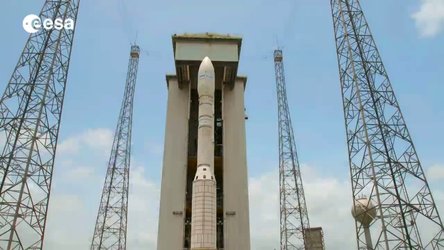Accept all cookies Accept only essential cookies See our Cookie Notice

About ESA
The European Space Agency (ESA) is Europe’s gateway to space. Its mission is to shape the development of Europe’s space capability and ensure that investment in space continues to deliver benefits to the citizens of Europe and the world.
Highlights
ESA - United space in Europe
This is ESA ESA facts Member States & Cooperating States Funding Director General Top management For Member State Delegations European vision European Space Policy ESA & EU Space Councils Responsibility & Sustainability Annual Report Calendar of meetings Corporate newsEstablishments & sites
ESA Headquarters ESA ESTEC ESA ESOC ESA ESRIN ESA EAC ESA ESAC Europe's Spaceport ESA ESEC ESA ECSAT Brussels Office Washington OfficeWorking with ESA
Business with ESA ESA Commercialisation Gateway Law at ESA Careers Cyber resilience at ESA IT at ESA Newsroom Partnerships Merchandising Licence Education Open Space Innovation Platform Integrity and Reporting Administrative Tribunal Health and SafetyMore about ESA
History ESA Historical Archives Exhibitions Publications Art & Culture ESA Merchandise Kids Diversity ESA Brand Centre ESA ChampionsLatest
Space in Member States
Find out more about space activities in our 23 Member States, and understand how ESA works together with their national agencies, institutions and organisations.
Science & Exploration
Exploring our Solar System and unlocking the secrets of the Universe
Go to topicAstronauts
Missions
Juice Euclid Webb Solar Orbiter BepiColombo Gaia ExoMars Cheops Exoplanet missions More missionsActivities
International Space Station Orion service module Gateway Concordia Caves & Pangaea BenefitsLatest
Space Safety
Protecting life and infrastructure on Earth and in orbit
Go to topicAsteroids
Asteroids and Planetary Defence Asteroid danger explained Flyeye telescope: asteroid detection Hera mission: asteroid deflection Near-Earth Object Coordination CentreSpace junk
About space debris Space debris by the numbers Space Environment Report In space refuelling, refurbishing and removingSafety from space
Clean Space ecodesign Zero Debris Technologies Space for Earth Supporting Sustainable DevelopmentLatest
Applications
Using space to benefit citizens and meet future challenges on Earth
Go to topicObserving the Earth
Observing the Earth Future EO Copernicus Meteorology Space for our climate Satellite missionsCommercialisation
ESA Commercialisation Gateway Open Space Innovation Platform Business Incubation ESA Space SolutionsLatest
Enabling & Support
Making space accessible and developing the technologies for the future
Go to topicBuilding missions
Space Engineering and Technology Test centre Laboratories Concurrent Design Facility Preparing for the future Shaping the Future Discovery and Preparation Advanced Concepts TeamSpace transportation
Space Transportation Ariane Vega Space Rider Future space transportation Boost! Europe's Spaceport Launches from Europe's Spaceport from 2012Latest

Cool test of Proba-V companion
Thank you for liking
You have already liked this page, you can only like it once!
A test version of ESA’s Proba-V Companion CubeSat seen during preparation for ‘thermal balance’ testing in the Agency’s Mechanical Systems Laboratory at its ESTEC technical centre in the Netherlands.
Space is a place where it is possible to be hot and cold at the same time, if one part of your satellite is in sunlight and another face in shade. A satellite’s interior needs to maintain a steady temperature to go on operating properly.
Accordingly this ‘structural and thermal model’ of the Proba-V Companion CubeSat was placed inside the Large Vacuum Facility of ESA’s Mechanical Systems Laboratory – employed to test large satellite systems or complete small satellites – for a week-long exposure to temperature extremes in space-quality vacuum.
Developed by prime contractor Aerospacelab in Belgium for ESA, this mission is a 12-unit ‘CubeSat’ – a small, low-cost satellite built up from standardised 10-cm boxes. It will fly a cut-down version of the vegetation-monitoring instrument aboard the Earth-observing Proba-V to perform experimental combined observations with its predecessor.
Launched in 2013, Proba-V was an innovative ‘gap filler’ mission between the Vegetation instruments monitoring global plant growth aboard the full-size Spot-4 and -5 satellites and compatible imagery coming from Copernicus Sentinel-3, the first of which flew in 2016.
By combining the views from three adjacent telescopes into one, Proba-V’s Vegetation achieved a continent-spanning swath of 2250 km, allowing to image the entire world’s plant growth in just over a day. But with its operational mission now over, Proba-V has shifted to experimental mode.
As part of that effort, the Proba-V Companion CubeSat will host a single telescope version of the Vegetation imager, left over from Proba-V development. The two missions will perform joint observations, to evaluate how well the instrument performs on a smaller, lower-cost platform.
Aerospacelab will also gain operational experience to be applied to its planned constellation of geospatial-information-gathering small satellites.
The flight version of the nanosatellite will undergo its own thermal balance testing at ESTEC later this year, while its instrument is due to be calibrated in the establishment’s Opto-Electronics Laboratory and its platform will be de-magnetised using ESTEC’s Magnetic Coil Facility. The Proba-V Companion CubeSat’s antenna underwent radio-frequency testing in January.
The mission is supported through the Fly in-orbit testing element of ESA’s General Support Technology Programme.
-
CREDIT
ESA/Aerospacelab -
LICENCE
ESA Standard Licence

Proba-V’s plus one

Proba-V passes the torch

VEGA VNR

Proba-V Flight Model undergoing vibration testing















 Germany
Germany
 Austria
Austria
 Belgium
Belgium
 Denmark
Denmark
 Spain
Spain
 Estonia
Estonia
 Finland
Finland
 France
France
 Greece
Greece
 Hungary
Hungary
 Ireland
Ireland
 Italy
Italy
 Luxembourg
Luxembourg
 Norway
Norway
 The Netherlands
The Netherlands
 Poland
Poland
 Portugal
Portugal
 Czechia
Czechia
 Romania
Romania
 United Kingdom
United Kingdom
 Slovenia
Slovenia
 Sweden
Sweden
 Switzerland
Switzerland

























